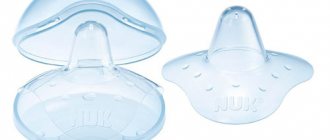03.28.2018 Category: LactationAuthor: Natalia Volobueva
From the beginning of pregnancy, most women study a lot of information. They are interested in knowing everything about baby care, care and development. However, one of the main issues that interest expectant mothers is breastfeeding. Mother's milk is the best source of nutrition for children in the first twelve months of life. Therefore, women strive to establish lactation and breastfeed their baby for as long as possible. But the GW process does not always go without problems. In most cases, nursing mothers encounter unpleasant symptoms: the appearance of cracks in the nipple area, soreness of the mammary glands. This may be the consequences of incorrectly attaching the baby to the breast. To avoid this, it is recommended from the very beginning of breastfeeding to pay attention to whether the child grasps the nipple correctly.
- Technique for attaching a baby to the breast
Comfortable positions for feeding a baby - How to position your baby correctly at the breast
Video: doctor about the rules of breastfeeding
How to put your baby to the breast
How to put a baby to the breast so that he is full, and the mother does not experience pain?
- Find a comfortable position with your back resting on the back of a sofa or chair. Excess tension will only make you tired and irritated, so make sure you are as relaxed as possible.
- Hold your baby so that his head rests on your forearm. The baby should be turned with its body and facing you, the ear, shoulder and tummy should be at the same level. Your baby's bottom arm should be pressed against his body and not between you and him.
- You don’t lean towards the baby, but bring him closer to your chest.
Why is it important
Breastfeeding is the most natural, simple and cheap way to nourish your baby. Mother's milk contains beneficial vitamins and microelements in the most easily digestible form for the baby. This is both drinking and eating for at least the first six months of a baby’s life, as well as during his illness. In addition, natural feeding forms an invisible thread of affection between mother and baby, gives the baby a feeling of security, and develops trust in the world.
Breastfeeding is important for an infant because:
- This is a natural, environmentally friendly multivitamin product,
- this is direct physical contact with the mother,
- this is a guarantee of safety and security in a new environment,
- it is a way of understanding the world around us,
- This is an excellent sleeping pill and sedative.
Breastfeeding is important for mothers:
- for the natural development of affection and emotional contact,
- You can devote more time to the baby, especially in our fast-paced times,
- is the prevention of breast diseases,
- you can feed your baby easily, quickly and without wasting time and money,
- During feedings you can rest and gain strength.
Baby's latching on the breast
It is important to give your baby not only the nipple, but also the areola. Take your chest with your hand so that your thumb is on the bottom and the rest on top. Pass the nipple along the baby's upper lip; he will respond by opening his mouth and searching for the breast. Place the nipple and areola into the baby's mouth so that his tongue is at the bottom, his lower lip is turned out, his chin touches his chest, and his nose is breathing freely. Point the nipple upward towards the baby's palate. The baby's mouth should be wide open, this will help him not to choke or swallow air. Your main goal is to move your lower lip and jaw as far away from the base of the nipple as possible. Thanks to this, the baby will take as much of the breast as possible into his mouth with his tongue and feed more effectively in terms of milk output, as well as painlessly for the mother. Try not to lean towards the baby, but to pull him closer to your chest. If applied correctly, it may only hurt in the first seconds; if the pain is constant, practice more. Usually all unpleasant sensations go away after 2 weeks and the mother experiences pleasure from breastfeeding.
Correct attachment to the breast - photo
What to do if the baby does not latch onto the breast correctly and the mother is in pain?
It is not surprising that the baby made a mistake and latched onto the breast incorrectly. After all, for him, breastfeeding is a skill that does not develop immediately. Therefore, you need to be patient and not get upset. You need to carefully insert your little finger into the baby's mouth, press on the lower jaw and remove the breast from the baby's mouth. Then try again.
Believe me, everything is very simple and children quickly learn to apply correctly. And it will not be at all difficult for you to comprehend the science of properly attaching your baby to the breast.
Signs of proper attachment
With proper attachment to the breast, the baby will suck the breast with a wide open mouth and actively working with the tongue. First, the baby will make several quick sucking movements, this stimulates the production of oxytocin and the flow of milk. After this, the baby will begin slow, deep sucking movements and you will hear him swallow. Sometimes the baby will pause, then the pauses will become more frequent as the feeding continues and the milk flow will slow down. If proper latching techniques are followed, your baby's body will relax as he feeds and he won't have difficulty breathing.
Throughout the feeding, leave the baby attached to the breast until he is ready to finish feeding, releasing the breast on his own while in a calm state.
Why is it so important that the baby receives colostrum and mother's breasts first?
The fact is that colostrum is a liquid unique in its composition, which is simply vital for a newborn baby. Colostrum is very similar to the amniotic fluid that the baby fed while inside the mother. Therefore, colostrum is ideal for a gradual transition to a new type of nutrition - mature milk. Colostrum is extremely nutritious and high in calories, it contains a huge amount of protein, vitamins A, C, B, E, hormones, antibodies and other protective factors that are so necessary for the baby. In addition, sucking on a bottle can prevent your baby from developing the habit of latching correctly.
Baby's behavior during feeding
The normal situation is that after a few minutes the baby releases the breast to burp, and then returns to feeding again. In this case, the milk flow may be at its maximum. If the baby spits out the breast during feeding, while being in a state of anxiety and irritation, then most likely he was incorrectly attached to the breast.
The baby shows that he has finished sucking the breast by releasing it from his mouth. You can offer him another breast, which the baby will take or not depending on his appetite. Do not interrupt breastfeeding or try to speed up feeding by shaking the baby or the breast. You should allow your baby to breastfeed unhindered until he is satisfied. In the first days of life, a small child may suckle for a long time and take long pauses during feedings.
Positions for feeding a newborn lying down
How to properly feed a newborn with breast milk
Often the very first position for latching is the reclining position (relaxed feeding). If a newly born baby is placed on his mother's stomach or chest, he will reflexively reach for the source of milk, trying to grab the nipple. Touching the skin stimulates the baby's feeding instinct, and the gravitational force helps him grasp while maintaining balance.
On a note. This position is very convenient for feeding not only newborns, but is also suitable for older children.
In addition, the relaxed position is ideal for cases when:
- The baby does not latch onto the breast well;
- Mom's breasts are too big;
- Mom has a strong milk flow;
- The baby does not like to have his head touched during lactation.
Recommendation. It is most convenient to feed in a reclining position supported by pillows. This method of attachment gives the woman the opportunity to monitor the baby during breastfeeding.
Another common relaxed feeding option is to lie on your side. Recommended for women who have undergone surgery during childbirth. During lactation, mother and newborn lie side by side, with their bellies touching.
Relaxed feeding while reclining on your back
Before feeding a newborn baby lying on its side, you should find out for which cases this option is most suitable:
- Mom had tears or a caesarean section;
- The woman does not get enough sleep, she is very tired, so it is difficult for her to sit during breastfeeding;
- The child has a shortened frenulum of the tongue, as a result of which it is difficult for the baby to grasp and hold the nipple in the mouth in other positions.
Jack
Feeding a newborn baby with breast milk while lying down in a jack position is not the most common position, but it is quite comfortable. With this method of attachment, the nursing woman and baby lie on their sides. The baby's legs are located along the mother's head. This method of application is recommended for lactostasis, that is, in cases where stagnation of milk is detected in the upper parts of the glands. With the correct positioning, the baby is saturated with milk, which comes from the upper walls of the chest. For greater safety and comfort, you can place a pillow under your child’s back.
Lactation in the jack position
Feeding in the hanging position
With this type of attachment, the baby lies on his back, and the mother bends over him, standing on all fours, with the nipple in the baby’s mouth. This position is recommended for mastitis and lactostasis, as well as for cases where the newborn cannot latch onto the breast. When feeding in the “overhanging” position, the mother can also sit, kneel next to the baby who is on an elevated platform (for example, on a bed) or lie in a reclining position, belly down and leaning on her elbows.
To relieve muscle tension and provide maximum comfort, you can use pillows of different sizes to rest on while breastfeeding.
On a note. The “overhanging” position is not popular because it is not very comfortable for a woman. There is no need to practice it constantly, except in cases where it is really necessary.
Feeding in the hanging position
Lying from the upper chest
With this attachment pattern, mother and baby lie on their sides facing each other. The baby lies on a pillow, the mother gives him the upper breast. Thanks to feeding "lying from the upper breast", the lower part of the mammary gland is actively emptied.
Riding Mom
Otherwise, this method is called the vertical pose or “koala pose.” The baby sits on the mother’s hip, his back is straight, his head is raised. This option is ideal for older children who can already sit on their own. Doctors also recommend the position for children who suffer from reflux or have a shortened frenulum of the tongue.
Painful sensations during feeding
In the first two weeks after childbirth, almost all mothers experience pain during breastfeeding, to the point where they wonder whether it is necessary to breastfeed their baby. Don't worry, if you follow proper breastfeeding techniques, you will definitely begin to enjoy this most important process in your baby's life. Normally, discomfort may occur in the first seconds after latching, and then disappear if, of course, the baby takes the breast correctly. But these feelings will completely go away after a while and breastfeeding will become a joy for you and your baby.
Convenience of feeding while lying down
This application option has a number of advantages:
- In this position, it will be comfortable for mom to rest;
- The child also feels comfortable;
- This position ensures correct nipple capture;
- The baby is at a sufficient distance from the edge of the bed so as not to fall.
However, it is very important not to be distracted during feeding, otherwise there is a risk of harming the baby. A child, for example, may roll out of bed and hit himself hard. Therefore, you need to secure the space around the baby in advance.
There are several variations of lying feeding:
- Relaxed or reclining position;
- Lying on your side;
- Reclining on the shoulder;
- Jack;
- "Overhang";
- Lying from the upper chest;
- Riding mom.
Each of the listed methods has its own nuances and features. How to properly feed a newborn with breast milk while lying down in each case will be discussed below.
The nuances of the correct positioning of the baby when feeding
It is very important to position the baby well relative to the mother so that his position is not only comfortable, but also conducive to the correct latching of the breast. The following nuances contribute to this:
We recommend reading: Breast pain during feeding
- The baby's body is pressed as close as possible to the mother's body, and the face is turned directly to the chest.
- The nipple is located at the level of the baby's nose.
- To open your mouth wider, you can touch your upper lip with your nipple.
- The baby's head should not be pinched. It is better if it is tilted back a little; in this position, the mouth will open wider.
- The nipple should be positioned so that the baby does not have to reach for it by twisting his neck.
- Do not squeeze your breasts with your fingers near the areola. This action will not help the flow of milk, but will only complicate the baby’s task to latch on correctly.
- If the breast is too large, then you need to hold it with your entire palm, placing it away from the nipple so that the baby’s nose is not pinched and he can breathe freely.
Under no circumstances should you use force on a child, force the breast into his mouth, or show your irritation and dissatisfaction - this will negate all efforts to master breastfeeding.
Common Mistakes
When breastfeeding, especially during the formation period, it is important to avoid the main mistakes:
- The key to success is the correct latching of the nipple by the baby. If this has happened, and the baby is used to latching on the breast as it should, he will cope with the task in any position. At the initial stage, it is important to follow the principle: the body and neck with the head are on the same line, the spine is not curved.
- A pillow or large breasts should not interfere with the child’s breathing or cover the nose.
- It is not recommended to position the baby when feeding on his back without raising his upper body. This makes it more difficult to swallow milk, belch air, or turn away if the flow is too strong.
- You cannot firmly fix the baby's head; he should always be able to turn around. It should only be lightly supported.
- It is forbidden to lean your chest onto your body or head to avoid injury.











